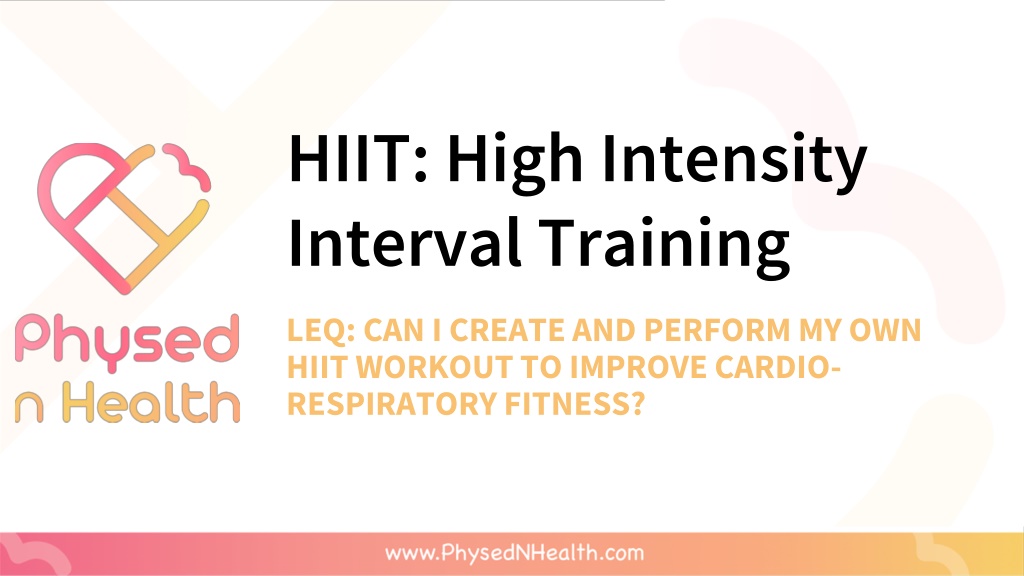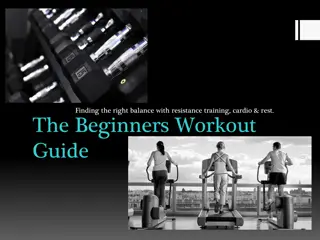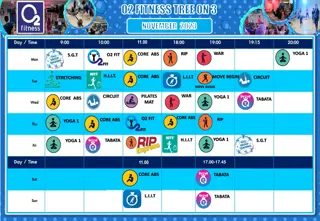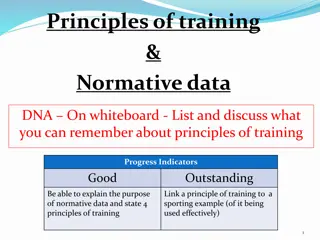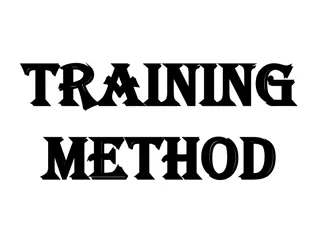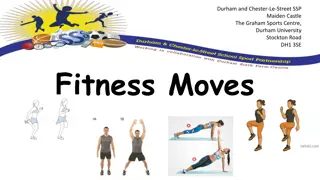Creating and Performing Your Own HIIT Workout for Improved Cardio-Respiratory Fitness
High Intensity Interval Training (HIIT) is a workout style involving intense exercise followed by recovery periods. You can create and perform your own HIIT workout to enhance cardio-respiratory fitness. HIIT offers various benefits, including breaking plateaus, preventing boredom, and maximizing health benefits in less time. Different HIIT types like Circuit Training can be tailored to individual preferences, providing flexibility and efficiency. Sample circuits and exercises make it easy to get started anywhere, ensuring a time-efficient yet effective workout routine.
Uploaded on Oct 01, 2024 | 0 Views
Download Presentation

Please find below an Image/Link to download the presentation.
The content on the website is provided AS IS for your information and personal use only. It may not be sold, licensed, or shared on other websites without obtaining consent from the author. Download presentation by click this link. If you encounter any issues during the download, it is possible that the publisher has removed the file from their server.
E N D
Presentation Transcript
HIIT: High Intensity Interval Training LEQ: CAN I CREATE AND PERFORM MY OWN HIIT WORKOUT TO IMPROVE CARDIO- RESPIRATORY FITNESS?
High Intensity Interval Training HIIT is a workout style that involves short periods of intense exercise alternated by recovery periods. Examples of HIIT include: Tabata EMOM AMRAP Circuit Training Interval Training
BENEFITS OF HIIT Change up workouts to prevent plateau in improvement and growth Perform different types of workouts to prevent boredom, keeping the brain challenged and engaged Most time-efficient way to exercise with no equipment required Provides maximum health benefits in less time Improves multiple components of health-related fitness
HIIT HEALTH BENEFITS Boosts mood and energy Improves cardio-respiratory fitness Strengthens muscles, bones, and joints Reduces muscular fatigue Increases metabolic rate Improves oxygen consumption of muscles Reduces heart rate and blood pressure Reduces blood sugar
TYPES OF HIIT: Circuit Training A series of moderate to vigorous exercises done in sequence with little to no rest. Rotate through a circuit of up to 10 exercises that target different muscle groups. Repetition circuit: Each exercise is performed for a certain number of repetitions (typically 10 15) before moving to the next exercise. 3 Move Rep Circuit: 10 biceps curls, 10 triceps kickbacks, 10 shoulder press Timed circuit: Each exercise is performed for a certain amount of time (30 90 seconds) before moving to the next exercise 4 Move Timed Circuit: 30 seconds jump squats, high knees, push ups, bicycles Circuit training refers to how the exercises are structured with sessions lasting between 20 60 minutes depending on personal goals.
BENEFITS OF CIRCUIT TRAINING Flexible and highly individualized Adjust the structure in various ways depending on personal preferences for exercise types, intensity, and duration. Makes working out more engaging and enjoyable Time efficient while improving strength and heart health
DO ANYWHERE CIRCUIT WORKOUT CIRCUIT 1 SQUAT JUMP HIGH KNEES SUMO SQUAT PUSH UPS RUSSIAN TWIST CIRCUIT 2 SPLIT LUNGES VERTICAL HINGE JUMP BASKETBALL JUMP JUMPING JACKS MT CLIMBERS BICYCLES CIRCUIT 3 SKATERS SIDE SHUFFLE PLANK JACKS TUCK UP Timed Circuit: Each exercise is performed for 30 seconds before moving to the next exercise. Rest for 30-60 seconds before repeating the circuit 2-3 times. Repeat process for all circuits for a total body strength and endurance workout.
WEIGHTED CIRCUIT WORKOUT CIRCUIT 1 Goblet Squat Back Lunge R Single Leg Deadlift R Back Lunge L Single Leg Deadlift L CIRCUIT 2 Biceps Curls Triceps Kickback Shoulder Press Bent Over Row Standing Chest Fly CIRCUIT 3 Sumo Squat DB Swing Curtsey Lunge R Curtsey Lunge L Alternate Snatch Rep Circuit: Perform 8-12 reps of each exercise with little to no rest between movements. Rest for 30-60 seconds before repeating the circuit 2-3 times. Repeat process for all circuits for a total body strength and endurance workout.
REFLECTION 1. ARE THE EFFORTS AEROBIC OR ANAEROBIC? 2. HOW COULD YOU USE THIS HIIT STYLE WHILE RUNNING, SWIMMING, BIKING, BOXING, OR JUMPING ROPE?
TYPES OF HIIT: Interval Training Combines short, high-intensity bursts of speed, with slow, recovery phases, repeated during one exercise session. Trains the aerobic and anaerobic system while improving speed. High-intensity efforts (anaerobic) use energy stored in muscles (glycogen) for short bursts of movement, producing lactic acid. The heart and lungs work together during the recovery phase (aerobic) to deliver oxygen to the muscles, convert stored carbs into energy, and break down lactic acid. The body adapts and burns lactic acid more efficiently allowing you to exercise at a higher intensity for a longer time before feeling fatigued.
DESIGNING AN INTERVAL WORKOUT Variables to manipulate an interval workout: Duration (distance or time) of work interval Duration of rest or recovery interval Intensity (speed) of work interval Number of repetitions of each interval
INTERVAL TYPES Longer Recovery Intervals: Short, all-out work interval followed by a longer recovery interval; 30-second sprint effort with a 1-minute walk/jog recovery. Longer Work Intervals: Shorten the recovery interval and lengthen the work interval; 45-second run effort with a 15 second walk/jog recovery. Mixed Work Intervals: Vary the length/intensity of the work intervals within a workout Timed pyramid of equal work to rest ratios (1 2 3 4 3 2 1) Distance pyramid of 2 to 1 work to rest ratios (200m, 400m, 600m, 800m, 600m, 400m, 200m) Music themed intervals: high-intense burst of speed during chorus and active recovery during the verse of a song
DO ANYWHERE TIMED INTERVAL WORKOUT HIGH-INTENSITY EFFORT 1 minute 2 minutes 3 minutes 4 minutes 3 minutes 2 minutes 1 minute RECOVERY PHASE 1 minute 2 minutes 3 minutes 4 minutes 3 minutes 2 minutes 1 minute Use any cardio activity to perform the timed interval workout like running, walking, cycling, swimming, rowing, jumping rope, elliptical, stair climber
LONGER WORK INTERVAL WORKOUT HIGH-INTENSITY EFFORT 400m RECOVERY PHASE 200m Use a cardio activity to perform the timed interval workout like running, walking, cycling, swimming, or rowing. Complete 5-10 reps of each interval depending on ability & goals Be sure to properly warm-up and cool down!
LONGER REST INTERVAL WORKOUT HIGH-INTENSITY EFFORT 30 seconds RECOVERY PHASE 1 minute Use a cardio activity to perform the timed interval workout like running, walking, cycling, swimming, or rowing. Complete 5-10 reps of each interval depending on ability & goals Be sure to properly warm-up and cool down!
BENEFITS OF INTERVAL TRAINING Increases cardio-respiratory efficiency and ability to deliver oxygen to working muscles Increases tolerance to lactic acid build up in the muscles Improved performance, greater speed, and better endurance Reduces risk of injuries associated with overuse Increases training intensity without overtraining or burnout
REFLECTION 1. IS INTERVAL TRAINING AEROBIC OR ANAEROBIC? 2. HOW DOES INTERVAL TRAINING REDUCE EXERCISE BOREDOM?
TYPES OF HIIT: TABATA A series of eight rounds of 20 seconds of work, 10 seconds of rest, all out effort The work to rest ratio is 2:1 with not enough time to fully recover before the next interval Perform a very high-intense effort for 20 seconds and rest for 10 seconds eight times for a four-minute block of work. Trains the aerobic and anaerobic energy systems to improve performance and personal fitness in a short amount of time
TABATA The 20 second work interval requires max effort, meaning it s a 9-10 on the RPE scale Tabata s can be performed with a variety of cardio activities and exercises Avoid overtraining and injury by participating in this style of workout no more than 1-2 days per week Add variety to workouts, get the most from an exercise session, and keep the mind engaged in the challenge
BODY WEIGHT TABATA TABATA SET 1 TABATA SET 2 TABATA SET 3 TABATA SET 4 SQUAT JACKS VERTICAL JUMPS HIGH KNEES SPLIT LUNGES PLANK JACKS PUSH UPS MT CLIMBERS BURPEE Perform the exercises in each Tabata set with 20 seconds work, 10 seconds rest, 8 times, alternating between the two exercises, repeating each move 4 times in the set Complete the Tabata sets, resting for up to one minute between sets. Push hard in each exercise effort, working at a 9 to 10 on the RPE scale Monitor intensity throughout the workout and reduce effort if heart rate gets too high. Adjust the workout as needed and modify any exercises that cause pain or discomfort.
WEIGHTED TABATA TABATA SET 1 TABATA SET 2 TABATA SET 3 TABATA SET 4 GOBLET SQUAT BACK LUNGE SUMO SQUAT FRONT SQUAT TRICEPS EXTENSION BICEPS CURL UPRIGHT ROW PUSH PRESS Perform the exercises in each Tabata set with 20 seconds work, 10 seconds rest, 8 times, alternating between the two exercises, repeating each move 4 times in the set Complete the Tabata sets, resting for up to one minute between sets. Push hard in each exercise effort, working at a 9 to 10 on the RPE scale Monitor intensity throughout the workout and reduce effort if heart rate gets too high. Adjust the workout as needed and modify any exercises that cause pain or discomfort.
REFLECTION 1. WHY ARE THE EFFORTS CONSIDERED ANAEROBIC? 2. HOW COULD YOU USE THIS HIIT STYLE WHILE RUNNING, SWIMMING, BIKING, BOXING, OR JUMPING ROPE?
TYPES OF HIIT: AMRAP Completing As Many Rounds or Reps As Possible in a set timeframe AMRAP based on rounds: select 3-6 exercises, a specific number of reps for each move, and a set amount of time Complete as many rounds of 10 push-ups, 10 superhumans, and 10 bicycles as possible in 4 minutes AMRAP based on reps: perform 1 exercise for a set amount of time and count number of reps How many burpees can you get in 1 minute? How many DB squats can you get in 2 minutes? How many jump rope rotations can you complete in 3 minutes?
BENEFITS OF AMRAP WORKOUTS Versatile and freedom to go at own pace Use heavy weights for strength gains Perform plyometric moves for cardio Do core exercises for an end of workout burnout Train the whole body or focus on a muscle group Design workout with low-impact or high-impact moves Use it as a benchmark or fitness assessment to monitor progress and celebrate success
AMRAP WORKOUT AMRAP 1: LOWER BODY FRONT SQUAT DEADLIFT BACK LUNGE SWING CLEAN AMRAP 2: UPPER BODY BICEPS CURL TRICEPS KICKBACK RENEGADE ROW PUSH UPS AMRAP 3: CORE SINGLE LEG BICYCLE R SINGLE LEG BICYCLE L BICYCLE CURL UP As Many Rounds As Possible: Complete 6-10 reps of each move consistently with little to no rest for a 4-5 minute block of work.
REFLECTION 1. IS AN AMRAP AEROBIC OR ANAEROBIC? 2. HOW COULD YOU USE THIS STYLE WHILE RUNNING, SWIMMING, BIKING, BOXING, OR JUMPING ROPE?
TYPES OF HIIT: EMOM Alternate between short bursts of intense exercise (anaerobic) with recovery periods. Every Minute On the Minute: complete exercise for a predetermined number of reps within 60 seconds. Use whatever time is left in minute to rest before starting the next minute. The longer it takes to complete the reps, the less time to rest so move with speed and power!
EMOM BENEFITS Quick and convenient No equipment required Build strength and train anaerobically Perform at the gym, next to your bed, or outside Add variety: focus on different muscle groups, change up equipment, perform more reps
EMOM TIPS Warm up muscle groups and elevate heart rate Overload muscle groups gradually Challenge by choice with reps and weights Use the rest time to allow heart rate to lower Use a watch or phone to monitor time and hold yourself accountable for the workout
BODY WEIGHT EMOM Minute 1 Minute 2 Minute 3 Minute 4 SQUAT JACKS, PLANK JACKS PUSH UPS, MT CLIMBERS SKATERS, BASKETBALL JUMPS TUCK JUMP, PLANK SHOULDER TAP Perform 10-15 reps of each move with speed & power, rest remainder of minute. Repeat the four-minute sequence 3-4x s. Push hard in each exercise effort, working at an 8-10 on the RPE scale Monitor intensity throughout the workout and reduce effort if heart rate gets too high. Adjust the workout as needed and modify any exercises that cause pain or discomfort.
WEIGHTED EMOM Minute 1 Minute 2 Minute 3 Minute 4 FRONT SQUAT TO PUSH PRESS SINGLE LEG DEADLIFT ROW R SINGLE LEG DEADLIFT ROW L SIDE LUNGE SWING CLEAN Perform 7-12 reps of each move with speed & power, rest remainder of minute. Repeat the four-minute sequence 3-4x s. Push hard in each exercise effort, working at an 8-10 on the RPE scale Monitor intensity throughout the workout and reduce effort if heart rate gets too high. Adjust the workout as needed and modify any exercises that cause pain or discomfort.
REFLECTION 1. WHY ARE THE EFFORTS CONSIDERED ANAEROBIC? 2. HOW COULD YOU USE THIS HIIT STYLE WHILE RUNNING, SWIMMING, BIKING, BOXING, OR JUMPING ROPE?
THINK, PAIR, SHARE What is your favorite style of HIIT? Why?
THINK, PAIR, SHARE How can you use your knowledge of the workout styles we do in class to create your own workout?
TYPES OF HIIT LEARNING ASSIGNMENT
TYPES OF HIIT QUIZ LEARNING ASSESSMENT
